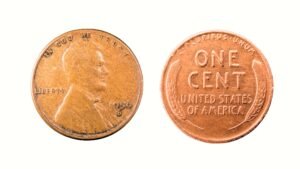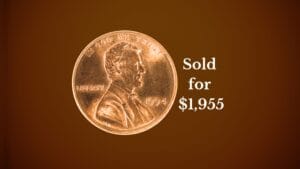If you have an old 1954 Lincoln Wheat Penny, you just got rich! This small cent sells for exceptional prices today, with rare examples reaching a whopping $30,000 or more!
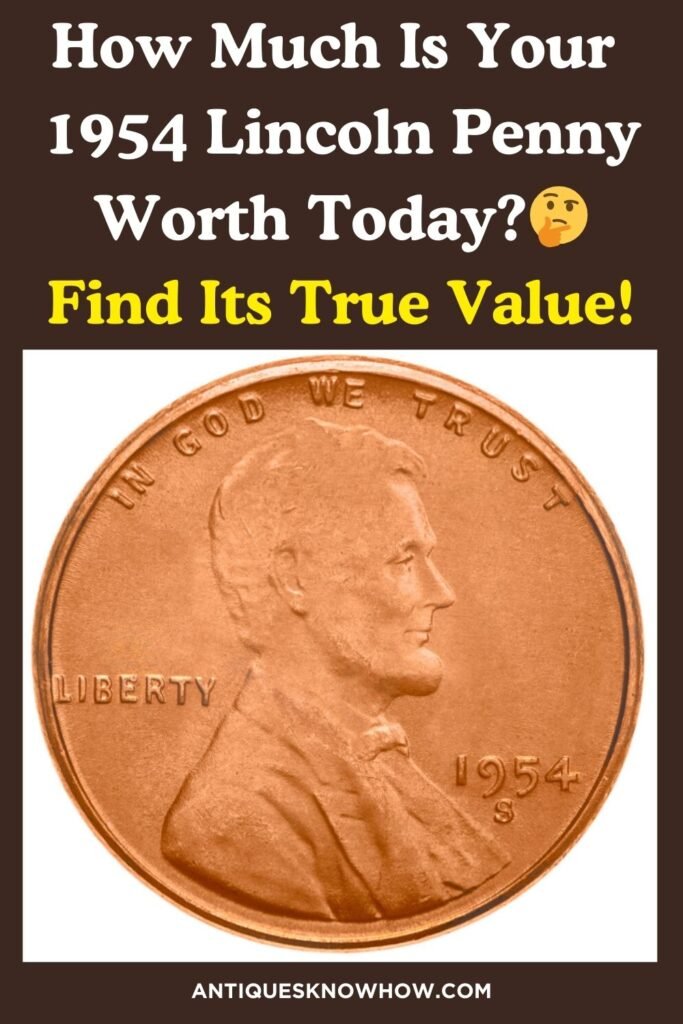
So, if you want to know whether your 1954 copper penny is a hidden gem, this guide will tell you exactly what features to look for!
Design & Features of a 1954 Lincoln Wheat Cent
Before evaluating a 1954 Lincoln penny value, you must authenticate it by verifying its design details and physical features. Here’s an overview of these:
1954 Lincoln Penny Obverse:
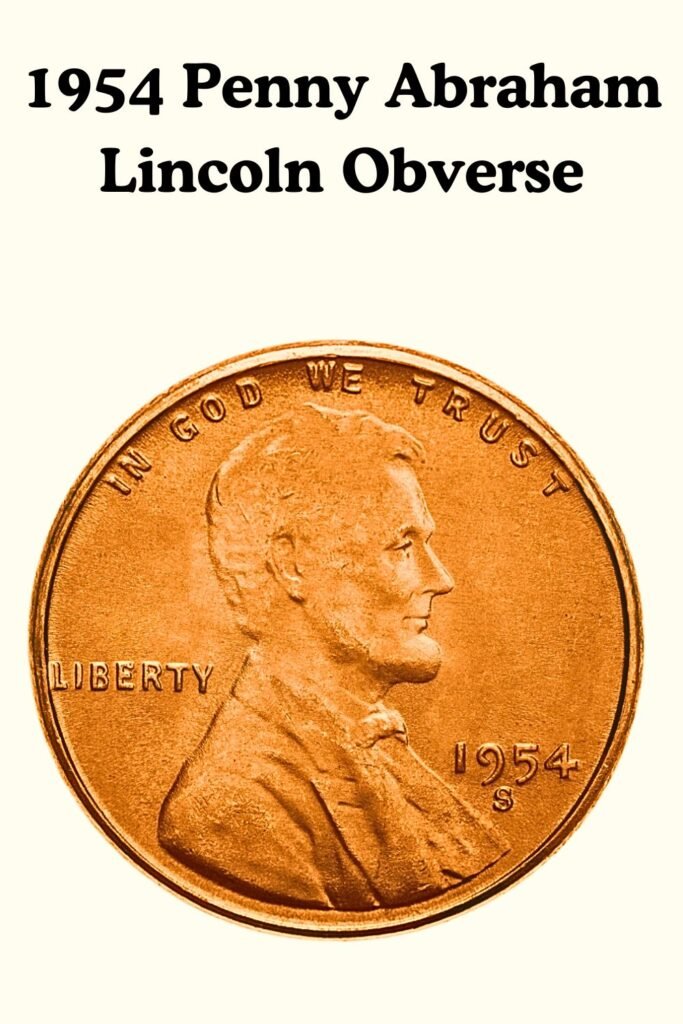
- A right-facing portrait of Abraham Lincoln
- The US motto “IN GOD WE TRUST” at the top
- “LIBERTY” to Lincoln’s left (back)
- “1954” to Lincoln’s right (lower right)
- The mint mark S or D, if present, below the date
1954 Lincoln Penny Reverse:

- “ONE CENT” in large letters in the center
- “UNITED STATES OF AMERICA” below the denomination
- Two wheat stalks surrounding the denomination & nation’s name
- “E PLURIBUS UNUM” at the top
1954 Lincoln Penny – Physical Characteristics
The 1954 Lincoln penny followed all the traditional features finalized for the series since its beginning in 1909:
| 1954 Lincoln Wheat Cent | Key Features & Facts |
| Coin Composition | 95% Copper, 5% Tin and Zinc |
| Minting Location | Philadelphia, Denver, San Francisco |
| Mint Date | 1954 |
| Face Value | 1-cent (0.01$) |
| Weight | 3.11 grams |
| Diameter | 19.05 mm |
| Thickness | 1.52 mm |
| Designer | Victor David Brenner |
| Mint Marks | D – Denver S – San Francisco No Mint Mark – Philadelphia |
| Total Mintage | 419,615,850 coins |
Assessing the Value of a 1954 Lincoln Penny
The value of a 1954 Lincoln penny largely depends on its condition and color. The former is assessed on a scale ranging from Poor to Gem Mint State, P-1 to MS-70. Mint state examples in high-grade fetch premium prices.
As for the color, the Lincoln cent is designated in three categories: Red (with at least 95% original mint luster), Red and Brown (with 5% and 94% original red color), and Brown (with only 5% mint luster).
Among these, Red 1954 Lincoln pennies are worth the most, fetching up to $30,000 or more, depending on other factors, like grade and mint marks.
Red-Brown and Brown pennies only fetch $10 to $100 in mint state, that too if it has an exceptionally high grade or a rare minting error.
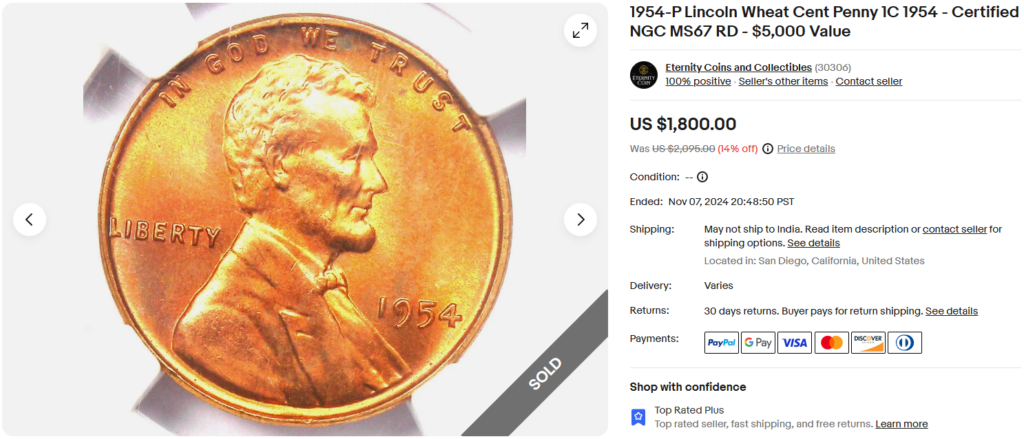
1. Mint Marks & Mintage
The 1954 Lincoln penny was produced at the three main facilities: Philadelphia, Denver, and San Francisco, with a total mintage crossing over 421 million coins. However, each mint produced a different number of coins with unique mint marks impacting their value and rarity!
1954 No Mint Mark Penny Value (Mintage – 71,640,050)
Due to the lowest mintage among all three mint facilities, the 1954 Lincoln Cent is the rarest and the most valuable coin, with one MS67 example fetching the highest auction record price of $31,200 at Heritage Auctions!
Here’s an estimated price range of a 1954 no-mint mark penny in the mint state:
- MS60-MS64: $2-$15
- MS65-MS65+: $15-$45
- MS66-MS66+: $60-$550
- MS67: $1,000-$30,000+
1954 S Penny Value (Mintage – 96,190,000)

With the second lowest mintage, the 1954 S wheat penny struck at the San Francisco Mint has a middle range value in mint state as given below:
- MS60-MS64: $2-$15
- MS65-MS65+: $15-$40
- MS66-MS66+: $20-$50
- MS67-MS67+: $80-$1,200+
- MS68: $8,700
1954 D Penny Value (Mintage – 251,552,500)
The highest mintage makes the 1954 Lincoln cent produced at the Denver mint quite common and less valuable. Here is an average price range of a 1954 D penny in mint state:
- MS60-MS64: $1-$10
- MS65-MS65+: $10-$25
- MS66-MS66+: $20-$70
- MS67-MS67+: $150-$1,200+
1954 Lincoln Proof Penny
The Philadelphia Mint produced 233,300 proof pennies in 1954 featuring exceptional detail and reflective finish, only for coin collectors. These proof coins come in three distinct varieties, each commanding different premium values.
Standard 1954 Penny Proof:
These 1954 Proof pennies display uniform mirror-like surfaces with values range as follows:
- PR60-PR64: $5-$20
- PR65-PR65+: $10-$25
- PR66-PR66+: $20-$45
- PR67-PR67+: $30-$100
- PR68: $110-$420
- PR69: $450-$1,400
1954 Penny Cameo Proof:
Cameo proofs, featuring frosted devices against mirror fields, command a 50-100% premium over standard proofs, like this PR68 example sold for $2,938 at Heritage Auctions!
- PR60-PR64: $10-$20
- PR65-PR65+: $30-$55
- PR66-PR66+: $60-$100
- PR67-PR67+: $150-$260
- PR68: $800-$3,000

1954 Deep Cameo Proof Penny:
The most desirable are Deep Cameo proofs, showcasing the most dramatic contrast between frosty devices and mirror fields. These can reach exceptional values, like this example in PR68 grade sold at Heritage Auctions for $14,950!
- PR60-PR64: $30-$275
- PR65-PR65+: $100-$300
- PR66-PR66+: $400-$550
- PR67-PR67+: $600-$2,500
- PR68: $4,000-$15,000
Valuable 1954 Lincoln Penny Errors
The 1954 penny series includes several valuable error varieties that excite collectors and command significant premiums.
Broad Strike Error
Broad strike or Broadstruck errors occur when coins are struck without a collar die, resulting in wider, thinner coins. A broadstruck 1954 Lincoln cent can fetch $50-$200 depending on condition and strike quality, like this MS62RB example sold for over $60 in a coin auction!
Double Die Errors (DDO and DDR)
Double Die errors, showing a distinct doubling of design elements on the obverse (DDO) or reverse (DDR), are particularly sought after. While no major doubled dies are known for 1954, minor doubled die varieties can bring $25-$100 depending on the strength of doubling and condition.
Off-center Strike Error
Off-center strikes happen when the coin blank is misaligned during striking. Look for a coin with part of the design missing. An off-center 1954 Lincoln cent can be worth $20 to $200, based on the percentage off-center and date visibility.
Curved Clip Error
This error happens when the coin planchet gets misplaced and a piece of it gets cut during minting, creating a crescent clip at the edge. A rare 1954 penny example with a curved clip error and an off-center error sold for over $335 on Heritage Auctions!
BIE Error (Die Crack)
The BIE error, showing a raised vertical line or die crack between the “B” and “E” of “LIBERTY” resembling the letter “I,” is unique to Lincoln cents. These die break errors typically command $25-$75 depending on the prominence of the break and the coin’s overall condition.
Note: This article is intended for informational, educational, and entertainment purposes only. Some images are illustrative and may not represent actual brands, products, or related entities. All trademarks, product names, brand logos, packaging, and other intellectual property referenced remain the exclusive property of their respective owners. Any brand mentions or references are provided solely for descriptive and educational context and do not imply any formal or commercial association.




